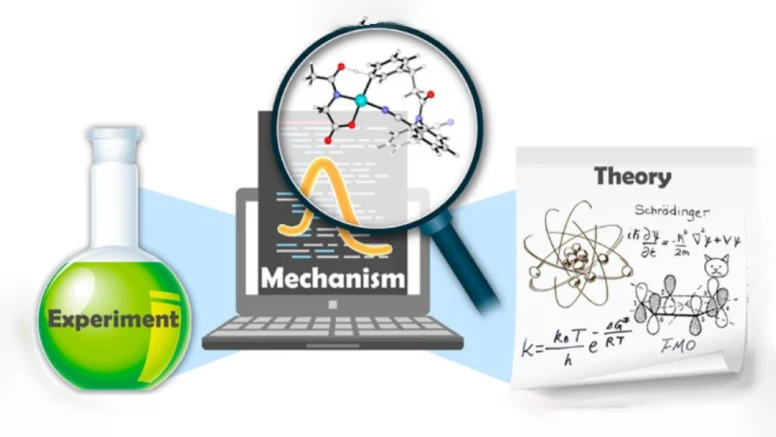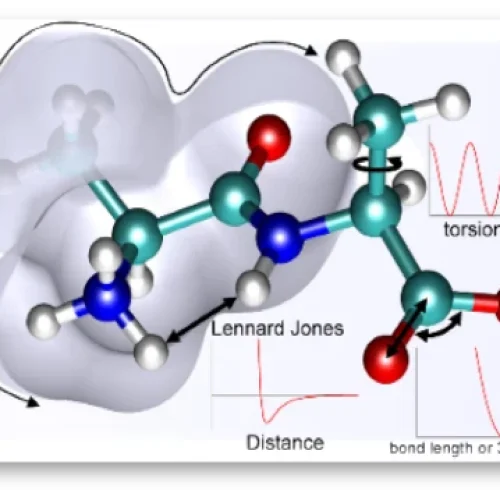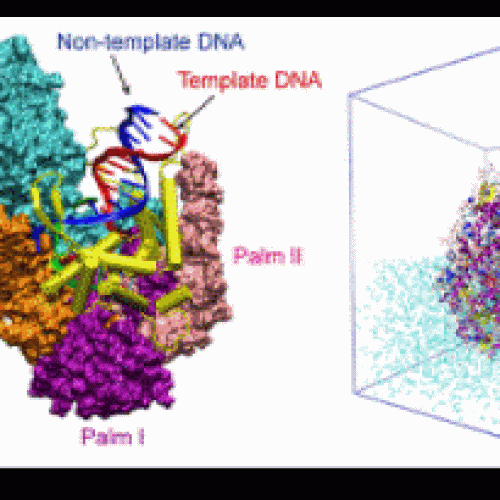Mehr als reine Theorie: Computational Chemistry
- News
- -
- Mehr als reine Theorie: Computational Chemistry

Computational Chemistry ermöglicht schnelleres, kosteneffektives und zielgerichteteres Forschen. Die Methode bietet auch für die Forschung zur industriellen Papierherstellung eine Reihe von Vorteilen.
Computational Chemistry oder computergestützte Chemie nutzt Computermodelle und -simulationen, um chemische Probleme zu verstehen und vorherzusagen. In der Wissenschaft wird die Methode angewendet, um Großprozesse zu verbessern, bei denen viele Intermediäre in einem komplexen Verbund zusammenwirken. Damit können Strukturen, Reaktionen und Eigenschaften von molekularen Systemen auf atomarer Ebene analysiert werden. Etwaige Auswirkungen von Veränderungen werden auf diese Weise zunächst einmal theoretisch am Computer modelliert und simuliert. Dadurch lassen sich Auswirkungen auf bestehende Prozesse oder chemische Phänomene testen.
Der Vorteil der Methode liegt klar auf der Hand: So können Computerchemiker Eigenschaften und Wechselwirkungen auf molekularer Ebene erforschen, die sonst schwer zu verstehen oder nur mit hohem Kostenaufwand und zeitaufwendigen Laborexperimenten zu ermitteln wären.
Die Berechnungen basieren auf der Lösung der Schrödingergleichung durch Anwendung mehrerer Ansätze und Annäherungen. „Je nach Größe der Moleküle oder den benötigten Eigenschaften können wir von Ab-initio-Berechnungen, die keine an experimentelle Daten angepassten Parameter verwenden, zu semi-empirischen übergehen und in weiteren Schritten zu molekularmechanischen und molekulardynamischen Berechnungen“, erklärt Dr. Jihène Jerbi, Vernetzungsmanagerin Wissenschaft und Innovationsscout bei der Modellfabrik Papier.
Wo wird Computational Chemistry bereits angewendet?
Computergestützte Chemie findet in zahlreichen Bereichen Anwendung. Zum Beispiel in der Materialwissenschaft im Bereich Elektronik, in der Medizin und in der Arzneimittelforschung, aber auch in Bereichen wie der Fasermodifikation für die Papierherstellung. Die Methode ermöglicht es Chemikern, Strukturen zu untersuchen, die aufgrund ihrer extrem geringen Größe sonst kaum zu betrachten wären. So können Nanopartikel, die kleiner als Atome sind, bei der Entwicklung und Optimierung von Wirkstoffmolekülen in der pharmazeutischen Forschung oder in der Entwicklung neuer Materialien mit spezifischen Eigenschaften modelliert und besser verstanden werden.
Wie funktioniert Computational Chemistry?
Die zugrundeliegenden Berechnungen basieren auf Erkenntnissen der Quantenmechanik und sind sehr rechenintensiv. „Zunächst untersuchen wir die Verteilung der Elektronendichte im Molekül, um die Bewegung der Elektronen innerhalb eines Moleküls besser zu verstehen. In diesem Stadium arbeiten wir mit einer Annäherung, um die Schrödingergleichung zu lösen und molekulare Eigenschaften oder Molekülstrukturen oder Bindungsenergien zu berechnen. Auf Software-Codes angewendet, können wir so Modelle der untersuchten Moleküle erstellen“, so Jerbi. Durch die Analyse der molekularen Orbitale, also der räumlichen Verortung der Elektronen um einen oder mehrere Atomkerne, lässt sich dann vergleichsweise leicht die Energie des Systems berechnen. „Auf dieser Grundlage können wir dann den weiteren experimentellen Weg vorhersagen.“
Je nach Größe des Systems wenden Wissenschaftler verschiedene computergestützte Techniken aus der Quantenmechanik oder der Molekulardynamik an. Für kleine Systeme werden Ab-Initio-Berechnungen angewendet, die sich auf quantenmechanische Prinzipien stützen, ohne auf experimentelle Daten oder empirische Parameter zurückzugreifen. So lassen sich physikalische Eigenschaften wie die Geometrie der Moleküle, das elektrische Dipolmoment und die Energie beschreiben. Auch können so die Eigenschaften einer Gesamtreaktion untersucht werden, wie Schwingungsfrequenzen, Reaktionsgeschwindigkeit, freie Energie und Reaktionsenergie.
Für größere Systeme wie biologische Moleküle wird die Molekulardynamik angewendet, um die Bewegung von Atomen und Molekülen über die Zeit zu simulieren. So lassen sich thermodynamische und mechanische Eigenschaften theoretisch untersuchen. Weil dafür aufgrund der Komplexität des Systems immer mehr Annäherungen benötigt werden, kommen zur Nachahmung des realen biologischen Systems molekül-mechanische Kraftfelder zum Einsatz. Hier gilt es, jedes einzelne Detail im Modell zu berücksichtigen, damit am Ende eine genaue Kopie des realen Moleküls entsteht.
Für andere Arten von Systemen wie Kristalle oder Cluster gibt es weitere Anwendungstechniken der Computational Chemistry.
Wie könnte Computational Chemistry in der Forschungsarbeit der Modellfabrik Papier zum Einsatz kommen?
„Wir könnten mit dieser Methode den Papierherstellungsprozess aus einem ganz anderen Blickwinkel betrachten“, ist Jerbi überzeugt. „Wir können auf diese Weise die enzymatische Behandlung und die Adsorption von Molekülen auf Zellulosefasern untersuchen und die inter- und intramolekularen Wechselwirkungen besser verstehen.“ Auch die Auswirkungen durch den Einsatz verschiedener Lösungsmittel, chemischer Füllstoffe, Additive und Leimungsmittel würden sich so simulieren und theoretisch beschreiben lassen. Auf Grundlage der Ergebnisse könnten die Forschungsteams kritisch diskutieren: Verstehen wir die grundlegenden Prozesse besser? Können wir mit diesen Erkenntnissen mit unserer Forschungsarbeit im Labor weiterarbeiten oder müssen wir einen Schritt zurückgehen?
„Computational Chemistry ist keine Einbahnstraße, sondern bietet immer die Möglichkeit, anzuhalten und neu anzusetzen, ohne große Zeit- und Kostenverluste zu erleiden“, betont Jerbi. „Es ist ein sehr leistungsfähiges Werkzeug zur Unterstützung oder Überwachung experimenteller Forschung. Richtig ist, dass die Berechnungen Energie kosten. Gleichzeitig liefern sie Erkenntnisse, die dazu beitragen Tonnen von Energie (aller Art), Wasser, Chemikalien und Fasern künftig einzusparen.“
© ACS 2015, ACS Omega 2019, CC Commons
Literaturnachweise:
Computational Organic Chemistry: Bridging Theory and Experiment in Establishing the Mechanisms of Chemical Reactions | Journal of the American Chemical Society (acs.org)
Computational chemistry – Simple English Wikipedia, the free encyclopedia
Analysis of Stability of Transcription System in Octane Media by Molecular Dynamics Simulation (x-mol.net)
Entdecken Sie weitere News
Sie haben Fragen?
Kommen Sie gerne auf uns zu wenn Sie mehr über die Modellfabrik Papier, unsere Aufgaben und unsere Projekte erfahren möchten.
Entdecken Sie weitere News
Erfahren Sie mehr über uns
Sie haben Fragen?
Kommen Sie gerne auf uns zu wenn Sie mehr über die Modellfabrik Papier, unsere Aufgaben und unsere Projekte erfahren möchten.
Zukunft gestalten
Wegweisend für eine nachhaltige Papierfertigung

Kontakt
- info@modellfabrikpapier.de
-
Aktueller Interimsstandort:
Forschungszentrum Jülich -
Postadresse:
Modellfabrik Papier gGmbH
August-Klotz-Straße 21 - 52349 Düren
Newsletter
Wir versenden zweimal im Jahr einen Newsletter und halten Sie damit rund um die Modellfabrik Papier auf dem Laufenden.
powered by JAM digital

